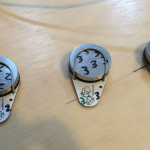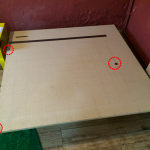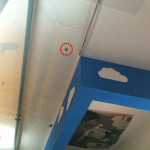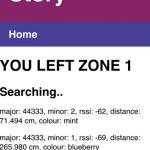Overview
This project involved evaluating the operating characteristics of iBeacons. These findings were used to develop an indoor positioning system that allowed users to interact with the system using their physical location. The system included a mobile application that interacted with the iBeacons to determine how close the user is to specific points in the room and delivered content to users. A system management web interface was also developed allowing user behaviour to be tracked and other content to be delivered.
I worked in collaboration with Hoffi whom I worked part time for to deliver this system for Yellobrick. Yellobrick customers use the mobile application and Yellobrick employees use the system management interface to track user behaviour.
This project received a mark of 83%.
Introduction
Interacting with users based on their indoor location provides many possibilities. Augmented reality gaming where the user’s physical location information is used to combine the virtual and real world is just one of these possibilities. Others include locating and tracking both people and objects indoors which has endless uses including navigation, advertising and finding objects.
Indoor Positioning Systems (IPS) have always been a challenge to create with there being many drawbacks including ever changing environments, but with endless opportunities many companies including Apple, Google and Microsoft are investing heavily in this industry.
Most people in the United Kingdom now own smartphones this has made interacting with IPS more accessible than ever. These technologies can be combined to deliver content to users in real-time based on their physical indoor location and allow organisations to track users physical location behaviour.
I will be working in collaboration with Hoffi whom I work part time for. Hoffi are a branding company based in Cardiff Bay who develop a brand strategy, identity and communications for businesses and organisations through a variety of methods including web and mobile development which is the area I work in.
Hoffi were contacted by a company called Yellobrick. They are a creative marketing agency that build engaging and participatory experiences for brands and organisations. They asked Hoffi to develop a user-friendly indoor system which would allow users to interact with it using their physical location. A mobile application will be used to tell the user how close they are to areas of interest and a system management interface will be needed so the system management team can track users and set up content for users. The project was set in December 2014 with a deadline of March 2015. This timeframe linked in well with my final year project. Once the project was finished the system was presented to the client in March when detailed feedback was received.
In the background section I will mention in detail what positioning systems and indoor positioning systems are. I will also review current indoor technologies where I will evaluate the different technologies and compare them to iBeacons.
To develop this prototype I will use the still relatively new Bluetooth IPS technology iBeacon developed by Apple in 2013. The iBeacons work by sending out Bluetooth low energy (BLE) signals to communicate with smartphones and other devices that support BLE. The BLE signal strength is used to calculate how far away a device is from a beacon.
The project will be split into a two-stage development process. The first stage will involve developing and evaluating the operating characteristics of iBeacons to find out the most accurate, efficient and suitable way to position a user indoors using iBeacon technology. This will be the experimental stage allowing me to undsertand how iBeacons work. I will then use these findings to help with the second stage of the project developing the Yellobrick system.
The Yellobrick system will be split into two sub-systems. A mobile application will be used by the Yellobrick customers and a system management interface will be used by Yellobrick employees. The mobile application will interact with the iBeacons to calculate the users position and then send this information to the server when location conditions are met. This application will also tell the user how far they are from each of the important locations and notify them if they enter a specific area. The system management interface will allow Yellobrick employees to view user behaviour and set up content on computer monitors. This content will vary depending on user behaviour. Some content will trigger when users enter specific locations and other content will only trigger when the user visits the locations in a specific order. Another part of the interface will involve a user walking close to a projected digital image and then this digital image will start moving. If another user gets close to the painting it will stop moving. The purpose of this is to confuse the user in a dark horror scene type setting. A database stored on the Hoffi server will be used so the two systems can interact with the same data.
The main scope of this system is to deliver a working system that allows users to interact with the system via a mobile application. The system will only be available locally so security won’t be a priority. As this is just a prototype demonstrating the potential of indoor positioning systems using iBeacons it is only essential it works on iOS, but in the future it would be nice if it worked across the two major platforms iOS and Android.
Main Aims and Objectives:
- Evaluate the IPS iBeacon technology and compare it with other IPS technologies.
- Investigate iBeacons to find the best way to accurately determine the position of a user in real time, deliver content to users at specific locations and track user “dwell times” anonymously at specific locations.
- Deliver a working prototype for Yellobrick on behalf of Hoffi that allows the user to interact with it using their physical location and Yellobrick employees to track user behaviour. This will showcase the different
Pictures
Technologies
- iBeacons
- JavaScript
- JQuery
- Cordova
- iOS
- MySQL
- PHP
- AJAX
- JSON
- HTML
- CSS
- Local Storage
Further Information
If you wish to find out more please contact me.



